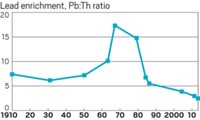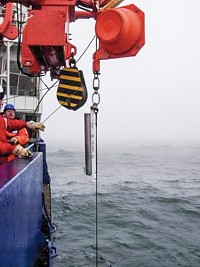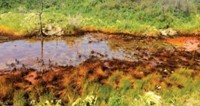Advertisement
Grab your lab coat. Let's get started
Welcome!
Welcome!
Create an account below to get 6 C&EN articles per month, receive newsletters and more - all free.
It seems this is your first time logging in online. Please enter the following information to continue.
As an ACS member you automatically get access to this site. All we need is few more details to create your reading experience.
Not you? Sign in with a different account.
Not you? Sign in with a different account.
ERROR 1
ERROR 1
ERROR 2
ERROR 2
ERROR 2
ERROR 2
ERROR 2
Password and Confirm password must match.
If you have an ACS member number, please enter it here so we can link this account to your membership. (optional)
ERROR 2
ACS values your privacy. By submitting your information, you are gaining access to C&EN and subscribing to our weekly newsletter. We use the information you provide to make your reading experience better, and we will never sell your data to third party members.
Environment
Lake Data Reveal Oil Sands Impacts
Environment: Oil production is dispersing carcinogenic hydrocarbons across northern Alberta, study shows
by Stephen K. Ritter
January 14, 2013
| A version of this story appeared in
Volume 91, Issue 2

New measurements on the ecological impact of Canadian oil sands mining and processing operations have provided the first clear evidence that concentrations of toxic polycyclic aromatic hydrocarbons (PAHs) are on the rise in the wilderness environment of northern Alberta. The findings may lead to tighter oil sands emissions controls on PAHs, mercury, CO2, and other pollutants.
Using a combination of radioisotope dating and mass spectrometry to analyze sediment layers in core samples from six small lakes, researchers say they have recorded levels of anthracenes, pyrenes, and dibenzothiophenes up to 23 times greater than natural background levels, and they are rising (Proc. Natl. Acad. Sci. USA, DOI: 10.1073/pnas.1217675110).

Scant environmental monitoring data have been collected in northern Alberta since commercial extraction and processing operations began there in the 1960s. The study was carried out by Joshua Kurek and John P. Smol of Queens University, in Kingston, Ontario, along with colleagues from Environment Canada.
“This study is significant in showing that the increase in PAHs has occurred almost in lockstep with increased oil sands production,” says David W. Schindler, an ecologist at the University of Alberta whose group studies oil sands pollutants.

Oil companies, government agencies, academic scientists, and environmental groups have been striving to find a balance in tracking and controlling emissions from the lucrative oil sands that is acceptable to all parties.
An industry-funded monitoring program began in 1997, and so far it has reported that levels of PAHs and other pollutants have not risen significantly above natural background levels. However, some scientists and environmental groups have criticized the program for not being sufficiently rigorous. A separate Canadian government-sponsored monitoring program was created last year to address that concern.
The microgram amounts of PAHs per gram of sample detected in the new study are lower than those found in urbanized areas, which are impacted by vehicle emissions and coal power plants, Schindler explains. “But it is clear that if tighter controls on PAH emissions are not imposed, the lake sediments will be approaching Canadian guidelines for toxicity soon,” he says.





Join the conversation
Contact the reporter
Submit a Letter to the Editor for publication
Engage with us on Twitter